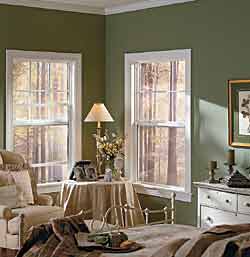Greater Vision: Alternate Window Materials in Commercial Buildings
Involving a LEED Accredited Professional in the process adds another point.
LEED uses performance-based requirements, so most building products will only contribute to achieving LEED points, not credits. To meet these, products with desired attributes should be specified.
|
Currently, LEED-NC (New Construction and Major Renovations/Additions) Version 2.1 involves window selection for commercial properties. USGBC expects to release Version 2.2 by Fall 2005.
Windows and doors can contribute to one prerequisite and up to 26 points in LEED-NC. Windows may contribute one point in the Sustainable Sites category under Light Pollution Reduction, dealing with light trespass from buildings. Although most of the credit revolves around outdoor lights, it includes interior light trespass through windows at night. Proper use of window treatments can contribute to this credit if they reduce glare or direct light shining onto neighboring property, streets, or night sky.
In the Energy and Atmosphere category, windows can contribute to 1 prerequisite and up to 13 points. Prerequisite 2-Minimum Energy Performance requires the building comply with ASHRAE/IESNA 90.1-1999 or the local code, whichever is more stringent. Windows can contribute to meeting the standard's building envelope requirements based on their energy efficiency, including low U-values, low air infiltration rates and low SHGC.
Windows can earn points in Credit 1-Optimizing Energy Performance. Up to 10 points are available with this credit and increase as energy costs decline so the window's energy efficiency is critical in maximizing this point category.
Points also can be earned in Credit 1-Technologies and Strategies for strategic placement of windows for natural ventilation, minimal undesirable air infiltration, maximum day lighting and minimum heat gain. Appropriate glazing to optimize natural lighting, heating and cooling also is point-worthy. The LEED Reference Guide notes only permanent interior shading devices such as between-glass blinds qualify for points.
Window material's content can earn points in Credit 4-Recycled Content. Aluminum, glass and wood can contribute to two points because they are recyclable materials and have recycled content. Additional points can be earned in Credit 5-Local/Regional Materials if the windows are made within 500 miles of the project site and another point can be added if a minimum of 50% of the building materials and products are extracted, harvested or recovered within the 500-mile guideline.
In the major category of Indoor Environmental Quality, windows can contribute up to 6 points. In Credit 2-Increase Ventilation Effectiveness, consider using operable windows to provide natural ventilation. Operable windows also can earn points in Credit 6-Controllability of Systems if an average of one operable window and one lighting control zone per 200 square feet are specified for all regularly occupied areas within 15 feet of the perimeter wall.
Windows can contribute to Credit 4.2-Low-Emitting Materials (Paints), if windows with low VOC paints and coatings for field-finishing of interior wood surfaces are chosen. In Credit 4.4- Low-Emitting Materials (Wood), eliminating urea-formaldehyde in composite wood products will contribute to this credit.
In Credit 8-Daylight and Views, windows earn credits for day lighting building interiors and views. Building orientation, window size and spacing, window placement for direct line of sight to exterior, glass selection, shading devices, light shelves, courtyards, atrium and window glazing should all be considered to earn points in this credit.
If the project is not going to be submitted for LEED certification, the program's requirements can be used as guidelines in evaluating window frame material for environmental impact.










